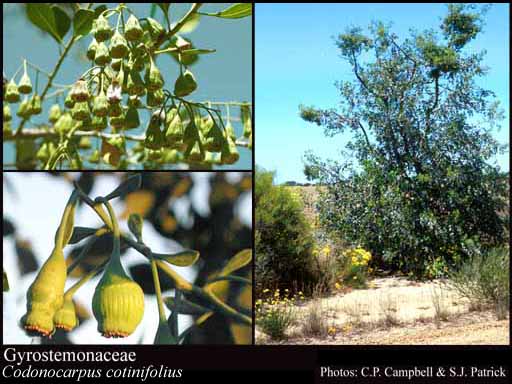- Reference
- Dict.Univ.Hist.Nat. 6:450 (1845)
- Name Status
- Current

Scientific Description
Common name. Gyrostemon Family.
Habit and leaf form. Trees, or shrubs (or undershrubs). Xerophytic. Leaves small, or medium-sized; alternate; spiral; fleshy (often), or ‘herbaceous’ to leathery; petiolate to sessile; non-sheathing; simple; epulvinate. Leaf blades entire; linear, or lanceolate, or oblanceolate, or oblanceolate, or ovate; one-veined, or pinnately veined. Leaves with stipules (the stipules minute), or without stipules; without a persistent basal meristem. Stem anatomy. Secondary thickening developing from a conventional cambial ring.
Reproductive type, pollination. Fertile flowers functionally male, or functionally female, or functionally male and functionally female. Unisexual flowers present. Plants dioecious (mostly), or monoecious.
Inflorescence and flower features. Flowers solitary, or aggregated in ‘inflorescences’; in racemes and in spikes. The terminal inflorescence unit racemose. Inflorescences racemose or spicate. Flowers bracteolate; small; regular; cyclic. Perianth sepaline; 4–5 (if segments detectable); 1 -whorled; joined (discoid or cupular, entire or more or less lobed). Calyx 4, or 5 (when lobed); 1 -whorled; gamosepalous; entire, or lobed; when not entire, lobulate, or blunt-lobed; regular; persistent. Fertile stamens present, or absent (female flowers). Androecium 6–100 (i.e., to ‘many’, arising from the edge of the flat or convex receptacle). Androecial sequence determinable, or not determinable. Androecial members when in more than one cycle, maturing centripetally; free of the perianth; all equal; free of one another; 1–5 -whorled. Androecium exclusively of fertile stamens. Stamens 6–100 (to ‘many’); commonly polystemonous; filantherous (shortly), or with sessile anthers. Anthers dehiscing via longitudinal slits; introrse. Fertile gynoecium present, or absent (male flowers). Gynoecium (2–)5–100 carpelled (i.e. to ‘many’). The pistil (2–)5–25 celled. Gynoecium apocarpous to syncarpous; semicarpous to synovarious (the carpels adnate to the central column, forming a compound ovary); superior. Carpel non-stylate to stylate; apically stigmatic; (if considered apocarpous) 1 ovuled. Placentation marginal. Ovary plurilocular; (if viewed as syncarpous) (2–)5–25 locular (i.e. as many locules as carpels). Gynoecium stylate, or non-stylate. Styles when present, (2–)5–25 (but very short); apical. Stigmas (2–)5–25 (the ring of stigmas forming a corona). Placentation axile. Ovules 1 per locule; apotropous; arillate; anatropous.
Fruit and seed features. Fruit fleshy (often, at first), or non-fleshy (finally); interpretable as an aggregate (if seen as resulting from more or less ‘free’ carpels). The fruiting carpels coalescing into a secondary syncarp to not coalescing. Fruit a schizocarp (the carpels separating from the central column), or dehiscent and a schizocarp. Mericarps comprising follicles, or comprising ‘legumes’ (the carpels dehiscing dorsally, ventrally or both). Seeds copiously endospermic. Endosperm oily. Embryo well differentiated. Cotyledons 2. Embryo curved.
Physiology, biochemistry. Mustard-oils present. Aluminium accumulation not found.
Geography, cytology, number of species. World distribution: Australia. X = 14, 15. 16 species.